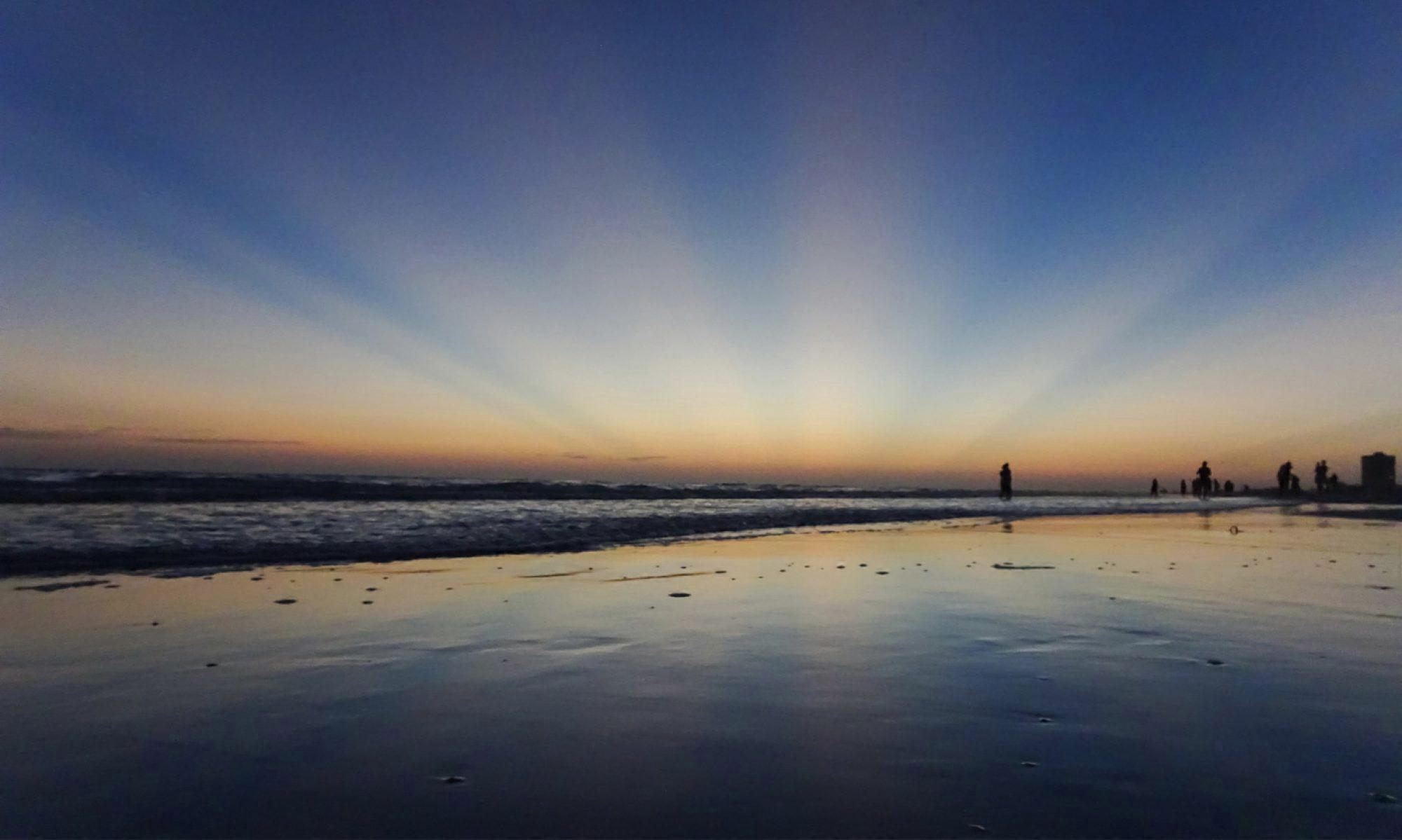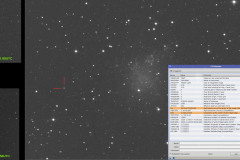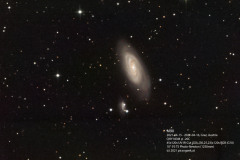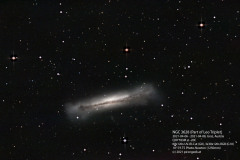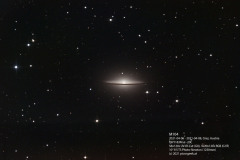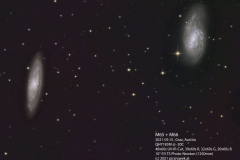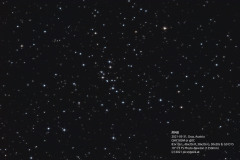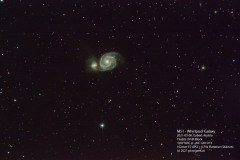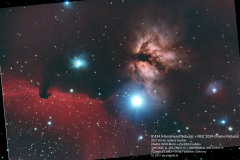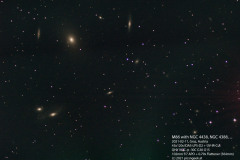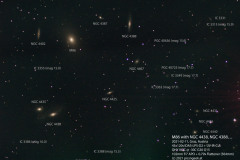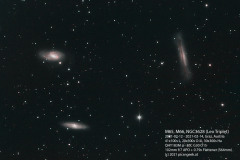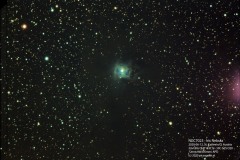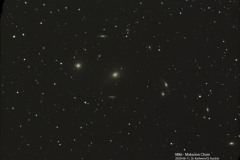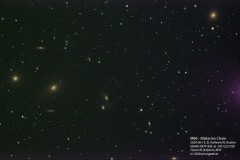During the last weeks I imaged IC1613, a dwarf galaxy of the local group in constellation Cetus. After stacking the images, I detected an object, which obviousely moved 28 arcsec during the 129 minutes I captured images on November 15th. It seems to be Asteroid (140) Siwa.
M90 Galaxy
This is my first image of Messier 90. It is not yet as good as I would like it to be. Which is due to bad weather preventing further imaging. As the moon is already too bright, I will have to postpone further imaging at least to the next new-moon phase.
Nevertheless, this image shows already a beautiful spiral galaxy with its companion.
Image data:
Date: 2021-04-15 – 2021-04-16
Location: Graz, Austria
Telescope: 10″ f/5 Newtonian with GPU corrector (1250mm focal length)
Camera: QHY183M @ -20C
Filters: Optolong RGB + Baader UV-IR-Cut
Guiding: MGEN-II with off-axis guider
Exposures:
UV-IR-Cut: 45x120s, Gain 0, Offset 15
R 30x120s, G 25x120s, B 23x120s, Gain 10, Offset 15
NGC 3628 – Galaxy in Leo Triplet
This is the third and dimmest galaxy of the Leo Triplet. The other two galaxies M65 and M66 are quite close, but did not fit in the image. They seem to be not only close in our view. The three galaxies might interact in gravitational forces.
The dust band in front of the edge on view of the galaxy render it a very interesting and beautiful deep sky target.
Image data:
Date: 2021-04-04 – 2021-04-08
Location: Graz, Austria
Telescope: 10″ f/5 Newtonian with GPU corrector (1250mm focal length)
Camera: QHY183M @ -20C
Filters: Optolong RGB + Baader UV-IR-Cut
Guiding: MGEN-II with off-axis guider
Exposures:
UV-IR-Cut: 60x120s, Gain 0, Offset 15
R, G, B: 30x120s, Gain 10, Offset 15
M104 – The Sombrero Galaxy
M104 is one of the deep sky objects, I could capture during the past week of clear nights. M104 is a rather difficult target for my balcony imaging, as it stays quite low. So the influence of the air movements cauesed by the city, I am looking over, is significantly increasing stars and reducing detail in the galaxy.
Apart from detail level – this 4 hours worth of imaging goes deep enough to clearly show at least 4 small and faint galaxies around M104. The faintest being at 17.9mag.
Image data:
Date: 2021-04-04 – 2021-04-08
Location: Graz, Austria
Telescope: 10″ f/5 Newtonian with GPU corrector (1250mm focal length)
Camera: QHY183M @ -20C
Filters: Optolong RGB + Baader UV-IR-Cut
Guiding: MGEN-II with off-axis guider
Exposures:
UV-IR-Cut: 58x120s, Gain 0, Offset 15
R, G, B: 20x120s, Gain 10, Offset 15
Project: Messier catalog from Bortle 6 home
After several months struggle with my 10 inch Newtonian telescope, I got all configured properly. Camera, Auto-Guider, APT, etc. are well tuned to produce nice and round stars, even in several minutes long exposures.
I am unable to view or image the whole sky from my balcony setup. I may only point to an area within 80 to 220 degrees azimuth (south-east to west-south-west) and an altitude from 12 degrees to at most 70 degrees. In several occasions, this is truly a very limited view, when objects are only visible for short periods. But still, my view is facing south. So over the course of one year, the majority of the well known deep sky objects are passing by. And for the rest of the sky, I will find opportunities to drive an hour to one of my mountain observing spots with Bortle 3-4 skies 🙂
Living on the northern edge of a city with a south-facing view is by far not a good combination for astronomy or astro-photography. Fortunately, the city I live in, is not too large. Therefore, my average night (if the sky is free from clouds), provides a Bortle 5-6 sky (most of the time 19.3 to 19.5 magnitues per square arc second). Visually, I have a hard time enjoying anything apart from the brightest objects. But imaging delivers really pleasing results.
During the last weeks of testing and imaging, I grew the idea to create my own Messier Object images catalog, where almost all images are recorded from this one location, with all its drawbacks. By pursuing this project, I want to show, that astronomy as well as astro-photography are still possible, even though light pollution gives us a hard time…
See the results, as I progress here: My Messier catalog from Bortle 6 suburban home
M48 and M65+M66 – finally with round stars
The past months I had trouble with my 10 inch scope. I was not able to image with nice round stars. So i kept imaging with my smaller refractor, as stars were rendered round. After some investigation and chat with fellow astronomy club members, I could nail down the cause of the elongated and triangular stars: the auto-guider as well as a too short settle time after dithering were messing up. So, to achieve the round stars everyone is after, I had to increase the settle time after dithering (otherwise, I got double-images due to the offset) as well as the guiding parameters in MGEN. My settings for off-axis guiding on 1250mm focal length are: Threshold: 0.1, Aggressivness: 100% in RA and 80% in DEC and 2×2 binning.
The first test target was M48 with 50% aggressiveness. Stars were not yet fine. The second target was M65 together with M66. Stars are fine!
Image data:
Date: 2021-03-31
Location: Graz, Austria
Telescope: 10″ f/5 Newtonian with GPU corrector (1250mm focal length)
Camera: QHY183M @ -20C
Filters: Optolong RGB
Guiding: MGEN-II with off-axis guider
Exposures:
M48: 83x10s L, 46x20s R, 30x20s G, 30x20s B
M65+M66: 48x60s L, 39x60s R, 32x60s G, 20x60s B
M51 and IC434/NGC2023
Saturday night, the sky was a spectacular sight. I had the chance to go out to one of my favorite places for observing. The sky was so full of stars – it was really a treat! A bit of “discomfort” posed the low temperatures, which were around -10C all night long.
As I arrived later than I hoped for, I immediately set my scope up. Scope and camera setup were up and ready for imaging soon. But then – a series of technical problems began. The scope did not fulfill GoTo commands properly. After solving this, the auto-guider could not calibrate well. I thought, it should be well enough. But upon inspecting the data back home, I had to discard more than 60% of the data due to elongated or totally ruined images. And finally, at around 2am my primary battery gave up (being only discharged 25%) due to the low temperatures. So I called it a night and went home.
The results I could gather are not as i was looking for. This is primarily due to the very low amound of data. But still, I add them here for the records…
Image data:
Date: 2021-03-06
Location: Gaberl, Austria (RGB) + Graz, Austria (H-alpha)
Telescope: 102mm f/7 APO with 0.79x flattener (equals to 564mm focal length)
Camera: QHY183C @ -20C (RGB) + QHY183M @ -30C
Filters: Baader UV-IR-Cut, Baader H-alpha
Guiding: MGEN-II with off-axis guider
Exposures:
IC434: 24x300s H-alpha, 19x60s RGB
M51: 19x60s RGB
Virgo Galaxies around M86
This is the next image captured last weekend. I recorded 114 individual exposures of 120s, from which I could use 43 due to clouds crossing in the night.
I annotated the image with the galaxies visible. Among them are:
M86 (mag 8.8)
NGC 4438 (mag 10.0)
NGC 4388 (mag 10.9)
NGC 4440 (mag 11.8)
NGC 4402 (mag 11.9)
and the faintest ones visible are
IC 3386 (mag 16.0)
IC 3349 (mag 17.7)
IC 3363 (mag 17.7)
PGC 40723 (mag 17.7)
Image data:
Date: 2021-02-11
Location: Graz, Austria
Telescope: 102mm f/7 APO with 0.79x flattener (equals to 564mm focal length)
Camera: QHY183C @ -30C
Filters: Baader UV-IR Cut + IDAS LPS-D2
Guiding: MGEN-II with off-axis guider
Exposures: 43x100s RGB
Leo Triplet with H-alpha and O-iii enhanced
During the last few days there were really promising clear nights. I recorded several data sets from my urban location (under these conditions, going up the mountains would have been a treat!). Now, as there are clouds again, I am processing the captured data. Here is the first result from the Leo Triplet (M65, M66 and NGC 3628).
I still have not yet received my color filters. So here I have a combination of luminance (UV-IR-Cut), H-alpha and O-iii data.
Image data:
Date: 2021-02-12 – 2021-02-14
Location: Graz, Austria
Telescope: 102mm f/7 APO with 0.79x flattener (equals to 564mm focal length)
Camera: QHY183M @ -30C
Filters: Baader UV-IR Cut + IDAS LPS-D2, narrow band Ha, Oiii
Guiding: MGEN-II with off-axis guider
Exposures: 41x100s Luminance, 20x300s O-iii (2x binning), 30x300s H-alpha (2x binning)
Sky-Quality: 19.4-19.6 mpss
